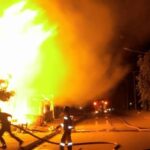
The Federal Capital Territory (FCT) has a total area of 8,000sqkm. The process for the selection of the actual site for the Federal Capital City (FCC) itself, within this vast land area, was based on detailed description and evaluation of its entire natural and man-made environment.
The choice of the North-eastern quadrant of the FCT otherwise referred to as the Gwagwa plains as the site for the FCC by the International Planning Associates (IPA), was guided by the area’s unique natural features for urban design purposes. This is among other major criteria after the IPA made an urban suitability analysis. First, the land scape is characterized by undulating terrain which enhances scenic beauty of cities. Also, the structural framework of the Capital City was guided by the locations of natural features that exist within the Gwagwa plains. These are mostly the rock outcrops, and to a lesser degree the stream channels.
It is still in the North-eastern portion of FCT that imposing mountain ranges that constitute the Bwari-Aso Hills which stretched from the Asokoro area of the City to Zuba, forms interesting landmark, and was made to be the outermost boundary of the City development. The Outer Northern Expressway observes the alignment of this mountain range to its north, from Asokoro to Zuba.
The areas between the Bwari-Aso Hills mountain ranges and the Northern and Southern limits of the City’s development, represented by the Outer Northern Expressway (ONEX) and the Outer Southern Expressway (OSEX) respectively, have been proposed to be greenbelts to serve as buffer zones between the City and its regional areas.
The aesthetics of the surrounding Suleja hills to the west, Zuma-Bwari-Aso hills to its north, Karu-Agwai hills to the east and the Zango-Kuku hills to the south also guided the site selection for the city’s location. Consequently, the Abuja Master Plan recommends that these areas require protection from development and preservation in their natural states.
The Master Plan observed that, of most immediate concern are those natural areas immediately adjacent to the FCC that are likely to experience the greatest pressure for change and suffer irreparable damage. Based on their unique geologic character and their prominent visual relationship to the FCC, two areas might be considered for preservation, perhaps by their designation as national monuments. They are the Zuma Hills areas and the southern scarp of the Bwari-Aso Hills.
Zuma Rock is one of the most distinctive and easily recognized inselberg in the entire region. However the greater portion of its surrounding area is located outside the FCT. Consequently, the Plan also suggested that areas outside the FCT might be considered for inclusion in the monument designation, since they are part of the visual “ensemble” which makes the Abuja area visually attractive and interesting.
The Aso Hill is the most prominent granite inselberg, the most dramatic and easily recognized feature within the FCC. The Aso Hill dominates view for as much as twenty miles. Due to its imposing posture in the vicinity of the Gwagwa plain, it becomes a prominent focal point. The Aso Hill forms a prominent land mark, from which point the City assumes a crescent shape. Indeed the Aso Rock is the starting point for laying the structural framework for the design of the FCC.
Abuja’s location at the geographical center of the nation offers her the unique privilege of being considered for the New Federal Capital of Nigeria. In 1983, just one year after the commencement of physical development in Abuja, students were selected from schools in the neighbouring towns for tour of the city. I was among those that were selected from Government Science College Izom in Niger State. I could vividly remember that the geographical center of Nigeria shown to us by the FCDA Protocol Officer was along the old Abuja – Nyanya road.
Subsequently, as a staff of the FCDA in 1990, while on a tour with visitors, I could also recollect that one of the protocol guides mentioned the Katampe Hill as the geographical center. Whichever is the correct location, it is necessary for the exact geographical center of Nigeria as located anywhere within the FCT, even if symbolic, should be clearly marked and treated as a National Landmark and Monument.




